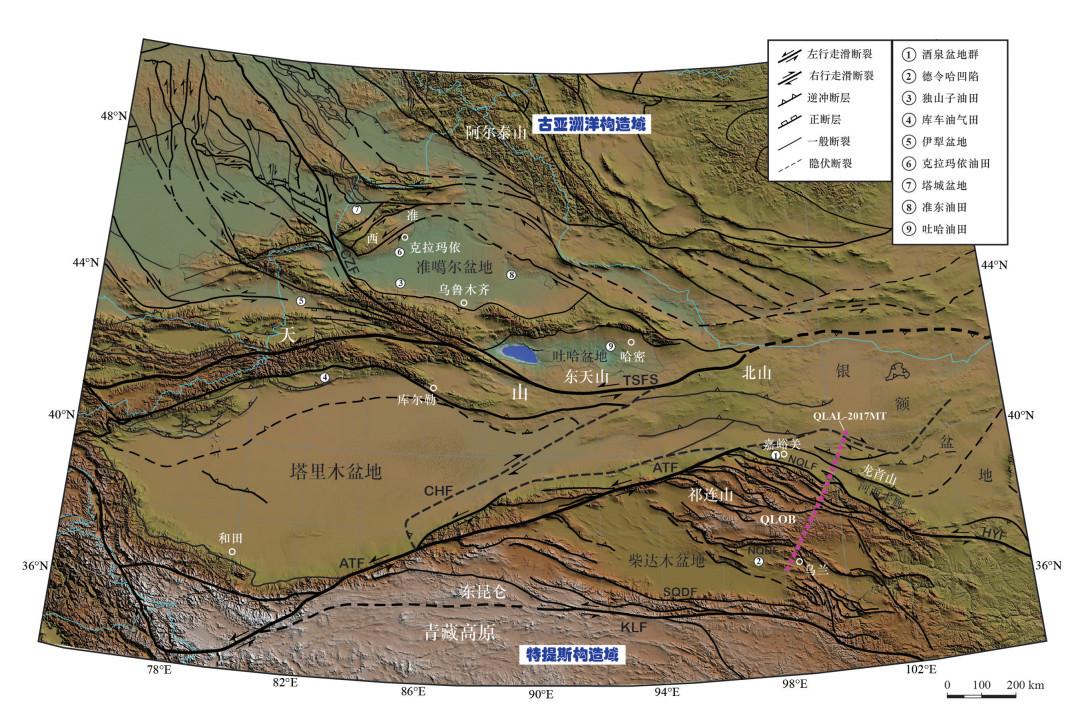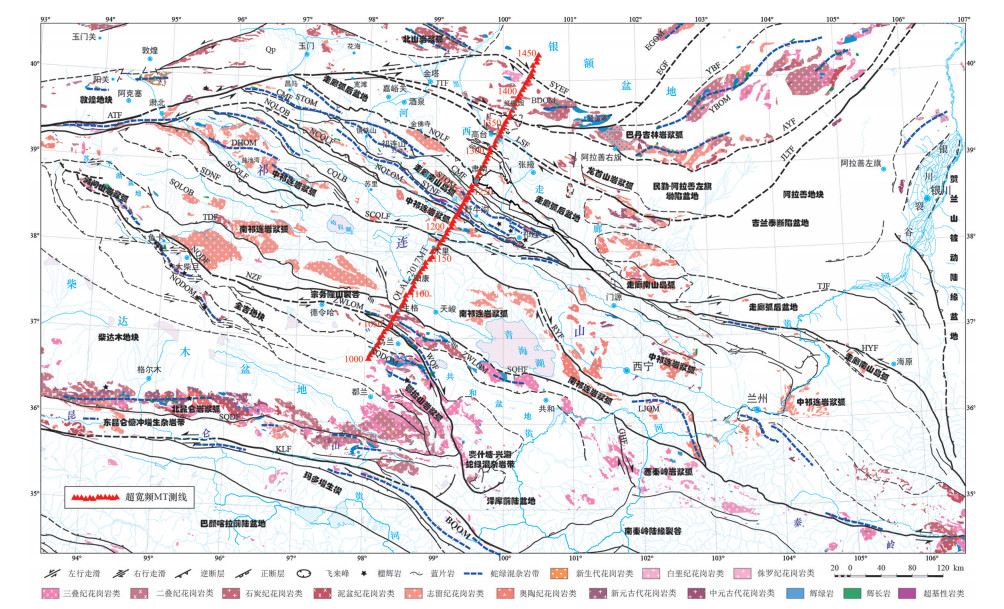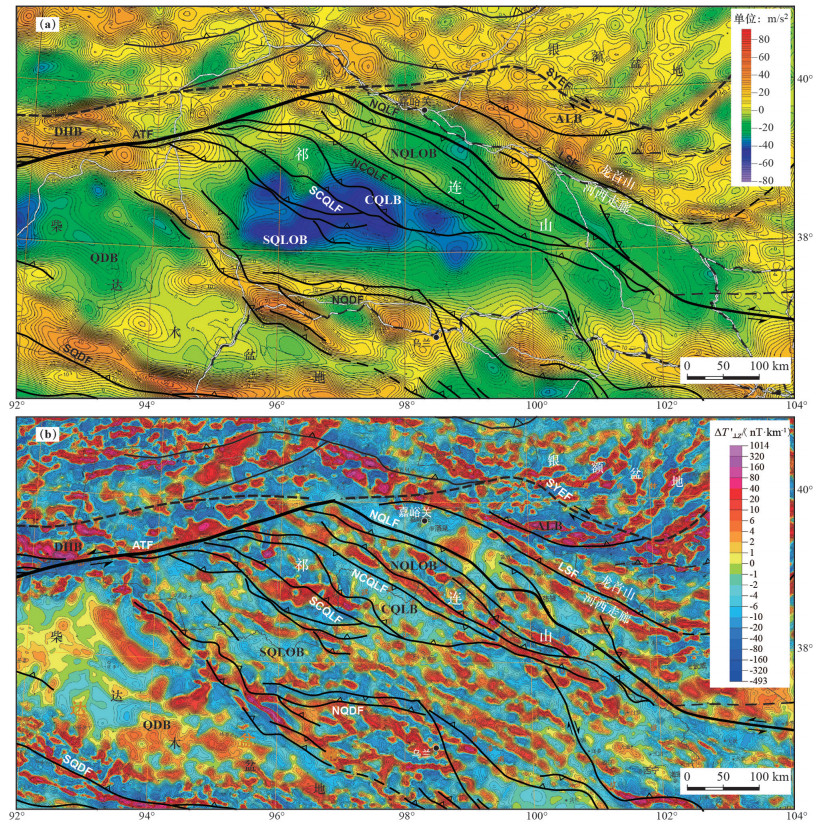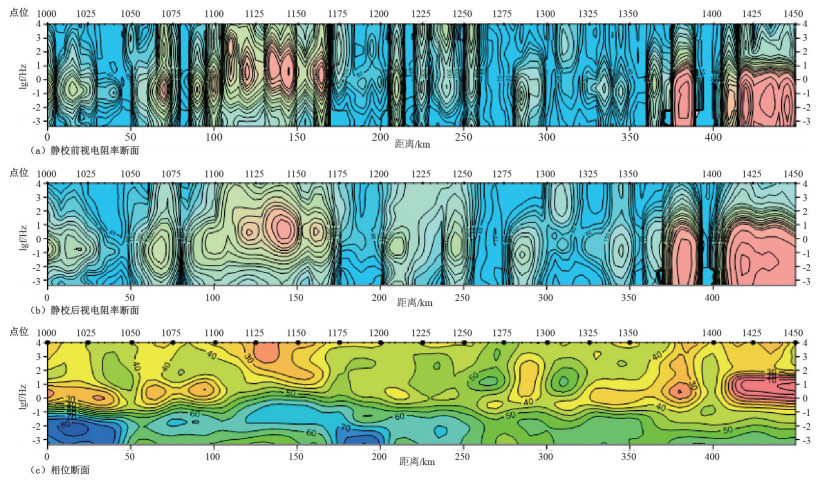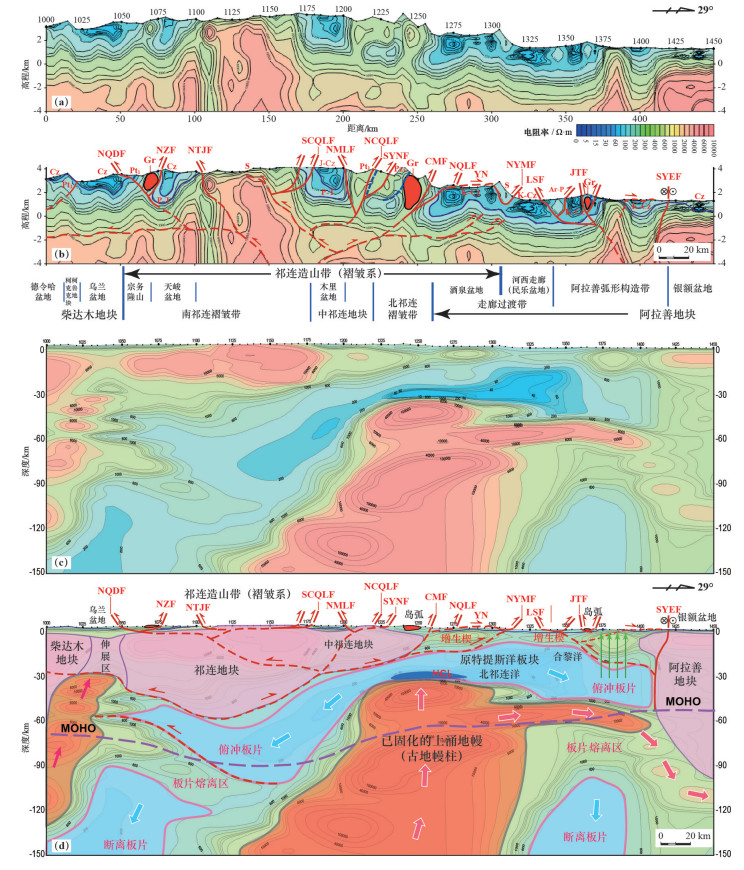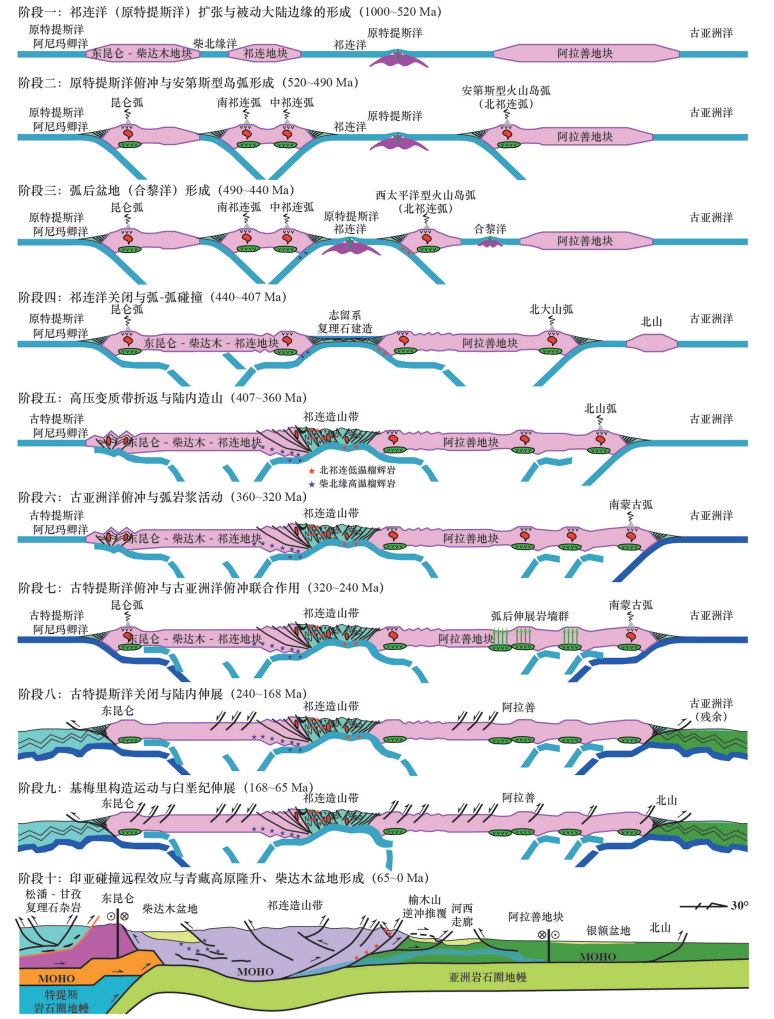Fault system, deep structure and tectonic evolution of the Qilian Orogenic Belt, Northwest China
-
摘要:
祁连造山带处在特提斯构造域的北缘,经历了早古生代原特提斯洋发育以来的构造演化,是青藏高原东北缘高原隆升与扩展的关键构造带。本文依据区域地质调查与构造地质填图,结合前人地球物理场资料,阐述了中国西北和祁连造山带断裂构造体系特征。通过超宽频大地电磁测深(MT)剖面数据采集处理,以及浅、中-深层电性剖面反演与构造解释,分析了祁连造山带全地壳深部结构特征与盆山耦合关系,揭示了原特提斯洋构造域北祁连洋板块向南和向北进行双向俯冲的化石俯冲带深部结构特征;俯冲消减的北祁连洋板块的宽度约在600 km以上。其中,北祁连洋向南在柴达木-祁连地块之下的俯冲作用角度较缓,俯冲带向南延伸的距离较远,其俯冲断离的板片可以达到现今柴达木盆地的北缘;北祁连洋向北的俯冲作用产状较陡,其俯冲断离的板片具有向南陡倾的产状倒转特征,可能与中生代以来、特别是印度-亚洲大陆碰撞的远程效应引起的挤压构造变形有关。大地电磁测深剖面的浅层反演与构造解释,验证了祁连山北缘断裂以北发育的榆木山逆冲推覆构造,榆木山构成飞来峰构造,将早白垩世酒泉盆地的一个分支掩盖在外来的逆冲推覆体之下;飞来峰之下具有油气勘查前景。根据早白垩世晚期普遍发育的伸展作用,限定榆木山逆冲推覆构造发育的时间在早白垩世早期,从而提供了青藏高原北缘早白垩世早期高原隆升与扩展的证据。综合前人资料和本研究成果,建立了祁连造山带自新元古代以来的构造演化概念模型。
Abstract:The Qilian Orogenic Belt (QLOB), located on the northern margin of the Tethyan tectonic domain, suffered from the development and evolution of the Early Paleozoic Proto-Tethyan Ocean (i.e., the North Qilian Ocean, NQO), and was the key orogenic belt for the uplift and expansion of the Tibetan Plateau on its northeastern margin. Based on regional geological survey and structure geological mapping and combined with previous geophysical data and newly completed super-broadband magnetotelluric (MT) sounding, this paper expounds the characteristics of the fault system in Northwest China and the QLOB. Through superbroadband MT data acquisition, processing, and inversion, and structural interpretation of shallow, medium and deep electrical structures along the MT profile across the QLOB, the distribution of Mesozoic and Cenozoic basins related to the fault system, and the deep crustal structure underneath the QLOB are analyzed. The deep electrical structure of the QLOB reveals a fossil bidirectional subduction of the NQO plate in the Proto-Tethyan tectonic domain. According to deep electrical structure, the original width of the subducted North Qilian Ocean plate was over 600 km. The southward subducted NQO plate probably reached the north margin of the Qaidam Block (the present Qaidam Basin) in the south, with a gentle subduction angle underneath the Central and South Qilian Block. Then, the melting-broken plate (or slab) might have migrated downward to the depth. In the north, the subducted NQO plate probably reached the southern margin of the Yin'e Basin of the present position, with a steep subduction angle. The dumpling melting-broken NQO plate was separated from the crustal retention plate in the north, through the northward extrusion of the upper mantle. The authors hold that the folding deformation of the subducted ocean plate was probably caused by the compressional tectonics in the Mesozoic and the Cenozoic, especially during the Late Cimmerian orogeny of Early Cretaceous and the India-Asian continental collision in Neogene. The shallow part of the electrical structure proves that the Yumushan thrustnappe structure was developed northward to the North Qilian Fault, with the Yumushan as a klippe in the north. The concealed Early Cretaceous basin underneath the klippe should be a good area for oil and gas prospecting. According to the normal faulting developed in the Early Cretaceous, the authors constrain the main stage thrusting of the North Qilian Fault in the Early Cretaceous, which might provide the evidence for the uplift and expansion of the northern margin of the Tibetan Plateau in the Early Cretaceous. Based on combined data from previous researches and this study, the authors put forward a conceptual tectonic evolution model for the Qilian Orogenic Belt.
-
致谢: 本文参加野外地质调查工作的还有徐盛林、张垚垚、王永超、邵浩浩、陈泓旭、韩建恩、史建杰、李江瑜、苗慧心、李杰、王洛娟、贺承广、韩乐乐、秦翔、余苇、丁伟翠、王叶、马飞宙、周琦等,研究工作得到中国地质调查局西北项目办和甘肃省张掖丹霞国家地质公园等的大力支持与帮助,东方地球物理公司综合物化探处协助完成QLAL-2017MT大地电磁剖面数据采集与资料处理,笔者在此一并表示衷心感谢。
-
图 1 亚洲构造简图(据任纪舜等,2013;陈宣华等, 2017, 2019b简化修改)
图中给出古亚洲洋构造域、西太平洋构造域和特提斯构造域的大致范围、主要克拉通和一些主要的大型断裂,以及图 2和图 3的位置
Figure 1. Sketch tectonic map of Asia (modified from Ren Jishun et al., 2013; Chen Xuanhua et al., 2017, 2019b)
The map shows general ranges of the Paleo-Asian Ocean, the Western Pacific and the Tethyan tectonic domains, the main cratons and some major large-scale faults, as well as the locations of Fig. 2 and Fig. 3
图 2 中国西北及周边地区断裂构造体系略图(据陈宣华等,2019a修改)
TSFS—天山走滑断裂系统;ATF—阿尔金断裂;CZF—成吉斯—准噶尔断裂;KLF—昆仑断裂;CHF—车尔臣河断裂;SQDF—柴达木南缘断裂;NQDF—柴达木北缘断裂;NQLF—祁连山北缘断裂;HYF—海原断裂;图中给出超宽频大地电磁测深剖面(QLAL-2017MT)的位置
Figure 2. Sketch map of the fault system of Northwest China and surrounding areas (modified from Chen Xuanhua et al., 2019a)
TSFS- Tianshan strike-slip fault system; ATF- Altun Fault; CZF- Chingiz-Junggar Fault; KLF-Kunlun Fault; CHF- Cheerchen Fault; SQDF- South Qaidam Fault; NQDF- North Qaidam Fault; NQLF- North Qilian Fault; HYF- Haiyuan Fault. The location of super-broadband magnetotelluric sounding profile (QLAL-2017MT) is shown in Fig. 2
图 3 祁连造山带及周缘断裂构造体系略图
SQLOB—南祁连造山带;CQLB—中祁连地块;NQLOB—北祁连造山带;ATF—阿尔金断裂;KLF—昆仑断裂;NQDF—柴达木盆地北缘断裂;SDNF—党河南山南缘断裂;TDF—土尔根达坂断裂;NZF—北宗务隆山断裂;SQHF—青海南山断裂;SCQLF—中祁连南缘断裂;NCQLF—中祁连北缘断裂;SYNF—野牛沟南缘断裂;CMF—昌马—俄博断裂;NQLF—祁连山北缘断裂;HYF—海原断裂;TJF—天景山断裂;WQF—温泉断裂;RYF—日月山断裂;GHF—共和断裂;LSF—龙首山断裂;JTF—金塔断裂;AYF—阿拉善右旗断裂;YBF—雅布赖断裂;EGF—恩格尔乌苏南缘断裂;SYEF—银额盆地南缘断裂。图中给出超宽频大地电磁测深剖面(QLAL-2017MT)的位置
Figure 3. Sketch map of the fault system of the Qilian Mountain Orogenic Belt and its adjacent areas
SQLOB-South Qilian Orogenic Belt; CQLB-Central Qilian Block; NQLOB-North Qilian Orogenic Belt. ATF-Altun Fault; KLF-Kunlun Fault; NQDF-North Qaidam Fault; SDNF-South Danghe Nan Shan Fault; TDF-Tuergendaban Fault; NZF-North Zongwulong Shan Fault; SQHF- South Qinghai Fault; SCQLF-South Central Qilian Fault; NCQLF-North Central Qilian Fault; SYNF-South Yeniugou Fault; CMF- Changma-Ebo Fault; NQLF-North Qilian Fault; HYF- Haiyuan Fault; TJF-Tianjingshan Fault; WQF-Wenquan Fault; RYF-Riyueshan Fault; GHF- Gonghe Fault; LSFLongshoushan Fault; JTF- Jinta Fault; AYF-Alxa Right Banner Fault; YBF- Yabulai Fault; EGF-South Engeerwusu Fault; SYEF-South Yin' e Fault. The location of super-broadband magnetotelluric
图 4 祁连山及周缘地球物理场异常及其与断裂构造体系的关系
a—剩余重力异常及其与断裂构造体系的关系,剩余重力异常据冯治汉等(2018);b—航磁∆T场化极垂向一阶导数异常及其与断裂构造体系的关系,航磁∆T场化极垂向一阶导数异常据熊盛青等(2015);ALB—阿拉善地块;NQLOB—北祁连造山带;CQLB—中祁连地块;SQLOB—南祁连造山带;QDB—柴达木地块;DHB—敦煌地块
Figure 4. Sketch maps showing the relationships between the geophysical field anomalies and the fault system in the Qilian Mountain and surrounding areas
a-Residual gravity anomaly (after Feng Zhihan et al., 2018) and its relationship with fault system; b-First vertical derivative anomaly of the aeromagnetic ∆T field polarization (after Xiong Shengqing et al., 2015) and its relationship with fault system; ALB-Alxa Block; NQLOB-North Qilian Orogenic Belt; CQLB- Central Qilian Block; SQLOB-South Qilian Orogenic Belt; QDB-Qaidam Block; DHB-Dunhuang Block
图 6 大地电磁测深反演剖面(QLAL-2017MT)的构造解释
a—共轭梯度法浅层反演剖面;b—浅层反演剖面的构造解释;c—共轭梯度法中—深层反演剖面;d—中—深层反演剖面的构造解释;断裂名称:NQDF—柴达木盆地北缘断裂;NZF—北宗务隆山断裂;NTJF—天峻盆地北缘断裂;SCQLF—中祁连南缘断裂;NMLF—木里盆地北缘断裂;NCQLF—中祁连北缘断裂;SYNF—野牛沟南缘断裂;CMF-昌马—俄博断裂;NQLF—祁连山北缘断裂;YN—榆木山逆冲推覆构造;NYMF—榆木山北缘断裂;LSF—龙首山断裂;JTF—金塔断裂;SYEF—银额盆地南缘断裂;Gr—花岗岩
Figure 6. Structural geological explanation of magnetotelluric sounding profile (QLAL-2017MT)
a-Inversion profile of shallow layers using conjugate gradient method; b-Structural interpretation of inversion profile of shallow layers; c-Inversion profile of middle to deep layers using conjugate gradient method; d-Tectonic interpretation of inversion profile of middle to deep layers. Fault names: NQDF-North Qaidam Fault; NZF- North Zongwulong Shan Fault; NTJF-North Tianjun Fault; SCQLF-South Central Qilian Fault; NMLF-North Muli Fault; NCQLF-North Central Qilian Fault; SYNF-South Yeniugou Fault; CMF-Changma-Ebo Fault; NQLF-North Qilian Fault; YN-Yumushan Nappe; NYMF-North Yumushan Fault; LSF-Longshoushan Fault; JTF- Jinta Fault; SYEF-South Yin' e Fault; Gr-Granite
-
Bai Jianke, Wang Hongliang, Zhu Xiaohui, Xie Congrui. 2016.Characteristics of olistostromes from the Ordovician Zhongbao Group in Shihuigou area, North Qilian orogenic belt and their palaeogeographic implications[J]. Geology in China, 43 (3):977-986 (in Chinese with English abstract). http://www.wanfangdata.com.cn/details/detail.do?_type=perio&id=zgdizhi201603020
Chen Bailin, Wang Chunyu, Cui Lingling, Liu Jianmin. 2008.Developing model of thrust fault system in western part of northern Qilian Mountains margin-Hexi Corridor basin during late Quaternary[J]. Earth Science Frontiers, 15 (6):260-277 (in Chinese with English abstract). http://en.cnki.com.cn/Article_en/CJFDTotal-DXQY200806035.htm
Chen Gan, Zheng Wenjun, Wang Xulong, Zhang Peizhen, Xiong Jianguo, Yu Jinxing, Liu Xingwang, Bi Haiyun, Liu Jinrui, Ai Ming. 2017. Present kinematics characteristics of the northern Yumushan active fault and its response to the northeastward growth of the Tibetan Plateau[J]. Seismology and Geology, 39 (5):871-888 (in Chinese with English abstract). http://www.wanfangdata.com.cn/details/detail.do?_type=perio&id=dzdz201705001
Chen Xuanhua, Yin A, Gehrels G E, Cowgill E S, Grove M, Harrison T M, Wang X-F. 2003. Two phases of Mesozoic north-south extension in the eastern Altyn Tagh range, northern Tibetan Plateau[J]. Tectonics, 22 (5):1053, DOI: 10.1029/2001TC001336.
Chen Xuanhua, Dang Yuqi, Yin An, Wang Liqun, Jiang Wuming, Jiang Rongbao, Zhou Suping, Liu Mingde, Ye Baoyin, Zhang Min, Ma Lixie, Li Li. 2010. Basin-mountain Coupling and Tectonic Evolution of Qaidam Basin and its Adjacent Orogenic Belts[M]. Beijing:Geological Publishing House, 1-365 (in Chinese).
Chen Xuanhua, Gehrels G, Yin A, Zhou Q, Huang P. 2015.Geochemical and Nd-Sr-Pb-O isotopic constrains on PermoTriassic magmatism in eastern Qaidam Basin, northern QinghaiTibetan plateau:Implications for the evolution of the PaleoTethys[J]. Journal of Asian Earth Sciences, 114:674-692. doi: 10.1016/j.jseaes.2014.11.013
Chen Xuanhua, Chen Zhengle, Han Shuqin, Yang Yi, Wang Zhihong, Jia Muxin, Ye Baoying, Shi Wei, Nie Lanshi, Ding Weicui, Bai Yanfei, Li Yong, Shi Jianjie, Li Bing, Shao Zhaogang, Liu Chunyong, Liu Gang, Zhang Yiping, Xu Shenglin, Ma Feizhou. 2017. Tectonic, Magmatic, and Metallogenic Evolution of the Balkhash and West Junggar Metallogenic Belt, Central Asia[M]. Beijing:Geological Publishing House, 1-539 (in Chinese).
Chen Xuanhua, Shao Zhaogang, Xiong Xiaosong, Gao Rui, Xu Shenglin, Zhang Yiping, Li Bing, Wang Ye. 2019a. Early Cretaceous overthrusting of Yumu Mountain and hydrocarbon prospect on the northern margin of the Qilian Orogenic Belt[J]. Acta Geoscientica Sinica, 40 (3):377-392 (in Chinese with English abstract). http://www.wanfangdata.com.cn/details/detail.do?_type=perio&id=dqxb201903001
Chen Xuanhua, Li Jiangyu, Dong Shuwen, Shi Wei, Bai Yanfei, Zbhang Yiping, Ding Weicui. 2019b. Tectonic deformation of Jurassic Ningwu-Jingle Basin and its implication for the beginning of Yanshanian Orogeny in Central North China Craton[J]. Geotectonica et Metallogenia, 43 (3):389-408 (in Chinese with English abstract). http://d.old.wanfangdata.com.cn/Periodical/ddgzyckx201903002
Chen Zhengle, Wang Xiaofeng, Yin An, Chen Bailin, Chen Xuanhua. 2004. Cenozoic left-slip motion along the central Altyn Tagh fault as inferred from the sedimentary record[J]. International Geology Review, 46:839-856. doi: 10.2747/0020-6814.46.9.839
Cheng Feng, Garzione C, Jolivet M, Wang Weitao, Dong Jibao, Richter F, Guo Zhaojie. 2019. Provenance analysis of the Yumen Basin and northern Qilian Shan:Implications for the precollisional paleogeography in the NE Tibetan plateau and eastern termination of Altyn Tagh fault[J]. Gondwana Research, 65:156-171. doi: 10.1016/j.gr.2018.08.009
Cui Junwen, Tang Zhemin, Deng Jinfu, Yue Yongjun, Meng Lingshun. 1999. Altun Fault System[M]. Beijing:Geological Publishing House, 1-249 (in Chinese).
Deng Jinfu, Wu Zongxu, Yang Jianjun, Zhao Hailing, Liu Houxiang, Lai Shaocong, Di Yongjun. 1995. Crust-Mantle petrological structure and deep processes along the Golmud-Ejin Qi geoscience section[J]. Acta Geophysica Sinica, 38 (Supp.Ⅱ):130-144 (in Chinese with English abstract). http://en.cnki.com.cn/Article_en/CJFDTOTAL-DQWX5S2.011.htm
Fen Zhihan, Liu Kuanhou, Guo Peihong, Wang Yilin. 2018.Characteristics of Gravity and Magnetic Fields in Northwest China and its Applications[M]. Wuhan:China University of Geosciences Press, 1-235 (in Chinese).
Gao Rui, Li Tingdong, Wu Gongjian. 1998. Lithospheric evolution geodynamic process of the Qinghai-Tibet Plateau:An inspiration from the Yadong-Golmud-Ejin Geoscience Transect[J]. Geeological Review, 44 (4):389-395 (in Chinese with English abstract). http://d.old.wanfangdata.com.cn/Periodical/OA000002454
Gao Rui, Wang Haiyan, Yin An, Dong Shuwen, Kuang Zhaoyang, Zuza A V, Li Wenhui, Xiong Xiaosong. 2013. Tectonic development of the northeastern Tibetan Plateau as constrained by high-resolution deep seismic-reflection data[J]. Lithosphere, 5(6):555-574. doi: 10.1130/L293.1
Gehrels G E, Yin A, Wang X F. 2003a. Magmatic history of the northeastern Ttibetan Plateau[J]. Journal of Geophysical Research, 108 (B9):2423, doi:10.1029/2002 JB001876.
Gehrels G E, Yin A, Wang X F. 2003b. Detrital-zircon geochronology of the northeastern Ttibetan Plateau[J]. Geological Society of America Bulletin, 115:881-896. doi: 10.1130/0016-7606(2003)115<0881:DGOTNT>2.0.CO;2
Gehrels G, Kapp P, DeCelles P, Pullen A, Blakey R, Weislogel A, Ding L, Guynn J, Martin A, McQuarrie N, Yin A. 2011. Detrital zircon geochronology of pre-Tertiary strata in the Tibetan-Himalayan orogen[J]. Tectonics, 30:TC5016, doi: 10.1029/2011TC002868.
George A D, Marshallsea S J, Wyrwoll K-H, Chen J, Lu Y. 2001.Miocene cooling in the northern Qilian Shan, northeastern margin of the Tibetan Plateau, revealed by apatite fission-track and vitrinite-reflectance analysis[J]. Geology, 29:939-942. doi: 10.1130/0091-7613(2001)029<0939:MCITNQ>2.0.CO;2
Guo Anlin, Zhang Guowei, Qiang Juan, Sun Yangui, Li Guang, Yao Anping. 2009. Indosinian Zongwulong orogenic belt on the northeastern margin of the Qinghai-Tibet plateau[J]. Acta Petrologica Sinica, 25 (1):1-12 (in Chinese with English abstract). http://www.wanfangdata.com.cn/details/detail.do?_type=perio&id=ysxb98200901001
IGCEA (Institute of Geology, China Earthquake Administration), LISCEA (Lanzhou Institute of Seismology, China Earthquake Administration). 1993. The Qilian Mountain-Hexi Corridor Active Fault System[M]. Bejing:Seismological Press, 1-340 (in Chinese with English abstract).
LISCEA (Lanzhou Institute of Seismology, China Earthquake Administration). 1992. Changma Active Fault Zone[M]. Bejing:Seismological Press, 1-207 (in Chinese).
Hao Guojie, Lu Songnian, Wang Huichu, Xin Houtian, Li Huaikun. 2004. The pre-Devonian tectonic framework in the northern margin of Qaidam basin and geological evolution of Olongbuluck palaeo-block[J]. Earth Science Frontiers, 11 (3):115-122 (in Chinese with English abstract). http://www.wanfangdata.com.cn/details/detail.do?_type=perio&id=dxqy200403013
Hetzel R, Tao Mingxin, Stokes S, Niedermann S, Ivy-Ochs S, Gao Bo, Strecker M R, Kubik P W. 2004. Late Pleistocene/Holocene slip rate of the Zhangye thrust (Qilian Shan, China) and implications for the active growth of the northeastern Tibetan Plateau[J]. Tectonics, 23:TC6006, doi: 10.1029/2004TC001653.
Hu Daogong, Qi Bangshen, Zhang Yaoling, Song Huanxin, Qi Shengsheng, Zhao Xitao, Zhang Xujiao, Wen Zhigang. 2018.Cenozoic Tectonic Environment Evolution and Uplift Process in Qilian Mountains[M]. Beijing:Geological Publishing House, 1-210 (in Chinese).
Huang Zengbao, Zheng Jianping, Li Baohua, Wei Zhijun, Qi Wei, Chen Xu. 2015. Geochronology and geochemistry of Yemashan batholiths in western Central Qilian and its tectonic implications[J]. Geology in China, 42 (2):406-420 (in Chinese with English abstract). http://www.wanfangdata.com.cn/details/detail.do?_type=perio&id=zgdizhi201502004
Jin Sheng, Zhang Letian, Jin Yongji, Wei Wenbo, Ye Gaofeng. 2012.Crustal electrical structure along the Hezuo-Dajing profile across the Northeastern Margin of the Tibetan Plateau[J]. Chinese Journal of Geophysics, 55 (12):3979-3990 (in Chinese with English abstract). http://www.wanfangdata.com.cn/details/detail.do?_type=perio&id=dqwlxb201212010
Katsura T, Baba K, Yoshino T, Kogiso T. 2017. Electrical conductivity of the oceanic asthenosphere and its interpretation based on laboratory measurements[J]. Tectonophysics, 717:162-181. doi: 10.1016/j.tecto.2017.07.001
Li Bing, Hu Daogong, Chen Xuanhua, Zhang Yaoling, Wu Huanhuan, Wang Chaoqun. 2017. Age and tectonic setting of the granite porphyry within Youhulugou ophiolite in the suture zone of the the North Qilian Mountain[J]. Geoscience, 31 (5):883-889 (in Chinese with English abstract). http://www.wanfangdata.com.cn/details/detail.do?_type=perio&id=xddz201706006
Li Bing, Chen Xuanhua, Andrew V. Zuza, Hu Daogong, Ding Weicui, Huang Penghui, Xu Shenglin. 2019. Cenozoic cooling history of the North Qilian Shan, northern Tibetan Plateau, and the initiation of the Haiyuan fault:Constraints from apatite-and zircon-fission track thermochronology[J]. Tectonophysics, 751:109-124. doi: 10.1016/j.tecto.2018.12.005
Li Fenqi. 2003. New evidence for the presence of the NS-trending extensional structures in northwestern China:An example from the Early Cretaceous half-graben fault depressions in Jiuquan, Gansu[J]. Sedimentary Geology and Tethyan Geology, 23 (2):35-42 (in Chinese with English abstract).
Li Meng, Wang Chao, Li Rongshe, Peng Yan. 2015. Age and provenance of the Yingou Group in Sunan area of North Qilian Mountain:Evidence from detrital zircon U-Pb dating[J]. Geology in China, 42 (3):601-615 (in Chinese with English abstract).
Li Qinghe, Zhang Yuansheng, Tu Yimin, Fan Bing. 1998. The combined interpretation of crustal velocity and electrical resistivity in Qilianshan Mountain-Hexi Corridor region[J]. Chinese Journal of Geophysics, 41 (2):197-210 (in Chinese with English abstract). http://en.cnki.com.cn/Article_en/CJFDTOTAL-DQWX199802008.htm
Li Sanzhong, Jahn Bor-ming, Zhao Shujuan, Dai Liming, Li Xiyao, Suo Yanhui, Guo Lingli, Wang Yongming, Liu Xiaochun, Lan Haoyuan, Zhou Zaizheng, Zheng Qiliang, Wang Pengcheng. 2017.Triassic southeastward subduction of North China Block to South China Block:Insights from new geological, geophysical and geochemical data[J]. Earth-Science Reviews, 166:270-285. doi: 10.1016/j.earscirev.2017.01.009
Li Sanzhong, Zhao Shujuan, Liu Xin, Cao Huahua, Yu Shan, Li Xiyao, Somerville I, Yu Shengyao, Suo Yanhui. 2018. Closure of the Proto-Tethys Ocean and Early Paleozoic amalgamation of microcontinental blocks in East Asia[J]. Earth-Science Reviews, 186:37-75. doi: 10.1016/j.earscirev.2017.01.011
Li Yalin, Wang Chengshan, Dai Jingen, Xu Ganqing, Hou Yunling, Li Xiaohan. 2015. Propagation of the deformation and growth of the Tibetan-Himalayan orogen:A review[J]. Earth-Science Reviews, 143:36-61. doi: 10.1016/j.earscirev.2015.01.001
Li Yulong. 1984. The characteristics and active period of Jiayuguan Fault[J]. Journal of Lanzhou University (Natural Science Edition), 20 (2):118-123 (in Chinese with English abstract). http://en.cnki.com.cn/Article_en/CJFDTOTAL-LDZK198402016.htm
Lü Qingtian, Meng Guixiang, Yan Jiayong, Zhang Kun, Zhao Jinhua, Gong Xuejing. 2019. Multi-scale exploration of mineral system:Concept and progress-A case study in the middle and lower reaches of the Yangtze River Metallogenic Belt[J]. Geology in China, 46 (4):673-689 (in Chinese with English abstract). http://d.old.wanfangdata.com.cn/Periodical/zgdizhi201904001
Naif S. 2018. An upper bound on the electrical conductivity of hydrated oceanic mantle at the onset of dehydration melting[J]. Earth and Planetary Science Letters, 482:357-366. doi: 10.1016/j.epsl.2017.11.024
Pan Guitang, Xiao Qinghui. 2015. Explanatory Note to the Tectonic Map of China (1:2 500 000)[M]. Beijing:Geological Publishing House, 1-160 (in Chinese).
Pan Hongxun, Ge Xiaohong, Liu Junlai. 2000. Query to the Yumushan uplift on the north margin of Qilian Mountain[J]. Journal of Changchun University of Scienceand Technology, 30 (1):9-13 (in Chinese with English abstract). http://www.wanfangdata.com.cn/details/detail.do?_type=perio&id=cckjdxxb200001002
Pei Xianzhi, Meng Yong, Ding Saping, Li Zuochen, Liu Zhanqing, Liu Huibin, Li Gaoyang, Li Ruibao. 2007. Identification of 2.5 Ga detrital zircons from Conjoint area between Qilian-Qinling Orogenic Belts and its geological implication[J]. Journal of Earth Sciences and Environment, 29 (2):111-116 (in Chinese with English abstract). http://www.wanfangdata.com.cn/details/detail.do?_type=perio&id=xagcxyxb200702001
Ren Jishun, Niu Baogui, Wang Jun, Jin Xiaochi, Xie Liangzhen. 2013.International Geological Map of Asia (1:5 000 000)[M]. Beijing:Geological Publishing House.
Ren Junjie, Xu Xiwei, Zhang Shimin, Ding Rui, Liu Hanyong, Liang Oubo, Zhao Junxiang. 2019. Late Quaternary slip rates and Holocene paleoearthquakes of the eastern Yumu Shan fault, northeast Tibet:Implications for kinematic mechanism and seismic hazard[J]. Journal of Asian Earth Sciences, 176:42-56. doi: 10.1016/j.jseaes.2019.02.006
Shao Haohao, Chen Xuanhua, Zhang Da, Shao Zhaogang, Li Bing, Wang Zengzhen, Zhang Yiping, Xu Shenglin, Shi Jianjie, Miao Huixin. 2019. The Lower Cretaceous tectonic deformation stages and detrital zircon U-Pb ages of Pingshanhu Basin in Hexi Corridor[J]. Geology in China, 46(5):1079-1093(in Chinese with English abstract).
Shi Wei, Liu Yuan, Liu Yang, Chen Peng, Chen Long, Cen Min, Huang Xingfu, Li Hengqiang. 2013. Cenozoic evolution of the Haiyuan fault zone in the northeast margin of the Tibetan Plateau[J]. Earth Science Frontiers, 20 (4):1-17 (in Chinese with English abstract). http://en.cnki.com.cn/Article_en/CJFDTOTAL-DXQY201304003.htm
Song S G, Yang J S, Xu Z Q, Liou J G, Shi R D. 2003a. Metamorphic evolution of the coesite-bearing ultrahigh-pressure terrane in the North Qaidam, Northern Tibet, NW China[J]. Journal of Metamorphic Geology, 21:631-644. doi: 10.1046/j.1525-1314.2003.00469.x
Song S G, Yang J S, Liou J G, Wu C L, Shi R D, Xu Z Q. 2003b.Petrology, geochemistry and isotopic ages of eclogites from the Dulan UHPM Terrane, the North Qaidam, NW China[J]. Lithos, 70:195-211. doi: 10.1016/S0024-4937(03)00099-9
Song S G, Zhang L F, Niu Y L, Su L, Jian P, Liu D Y. 2005.Geochronology of diamond-bearing zircons from garnet peridotite in the North Qaidam UHPM belt, Northern Tibetan Plateau:A record of complex histories from oceanic lithosphere subduction to continental collision[J]. Earth and Planetary Science Letters, 234:99-118. doi: 10.1016/j.epsl.2005.02.036
Song S G, Zhang L F, Niu Y L, Su L, Song B A, Liu D Y. 2006.Evolution from oceanic subduction to continental collision:a case study from the Northern Tibetan Plateau based on geochemical and geochronological data[J]. Journal of Petrology, 47:435-455. doi: 10.1093/petrology/egi080
Song Shuguang, Niu Yaoling, Zhang Lifei, Wei Chunjing, Liou J G, Su Li. 2009. Tectonic evolution of early Paleozoic HP metamorphic rocks in the North Qilian Mountains, NW China:New perspectives[J]. Journal of Asian Earth Sciences, 35:334-353. doi: 10.1016/j.jseaes.2008.11.005
Song Shuguang, Niu Yaoling, Zhang Lifei, Zhang Guibin. 2009. Time constraints on orogenesis from oceanic subduction to continental subduction, collision, and exhumation:An example from North Qilian and North Qaidam HP-UHP belts[J]. Acta Petrologica Sinica, 25 (9):2067-2077 (in Chinese with English abstract).
Song Shuguang, Niu Yaoling, Su Li, Xia Xiaohong. 2013. Tectonics of the North Qilian orogen, NW China[J]. Gondwana Research, 23(4):1378-1401. doi: 10.1016/j.gr.2012.02.004
Song S G, Niu, Y L, Su L, Zhang C, Zhang L F. 2014. Continental orogenesis from ocean subduction, continent collision/subduction, to orogen collapse, and orogen recycling:The example of the North Qaidam UHPM belt, NW China[J]. Earth-Science Reviews, 129:59-84. doi: 10.1016/j.earscirev.2013.11.010
Sun Jiaopeng, Chen Shiyue, Hu Zhongya, Liu Wenping, Guo Chen, Ma Shuai. 2014. Research on the mixed model and developmental characteristic of the clastic-carbonate diamictite facies in the northern Qaidam[J]. Natural Gas Geoscience, 25 (10):1586-1593(in Chinese with English abstract). http://www.wanfangdata.com.cn/details/detail.do?_type=perio&id=trqdqkx201410011
Sun Yangui, Zhang Guowei, Wang Jin, Zhan Fayu, Zhang Zhiyong. 2004.40Ar/39Ar age of the basic sill swarms of two periods in the Junction area of Qinling and Kunlun and its tectonic significance[J]. Acta Geologica Sinica, 78 (1):65-71 (in Chinese with English abstract). http://www.wanfangdata.com.cn/details/detail.do?_type=perio&id=dizhixb200401008
Tang Ji, Zhan Yan, Zhao Guoze, Deng Qianhui, Wang Jijun, Chen Xiaobin, Zhao Junmeng, Xuan Fei. 2005. Electrical conductivity structure of the crust and upper mantle in the northeastern margin of the Qinghai-Tibet plateau along the profile Maqen-LanzhouJingbian[J]. Chinese Journal of Geophysics (in Chinese), 48(5):1205-1216 (in Chinese with English abstract). http://en.cnki.com.cn/Article_en/CJFDTOTAL-DQWX200505031.htm
Tapponnier P, Meyer B, Avouac J P, Peltzer G, Gaudemer Y, Guo Shunmin, Xiang Hongfa, Yin Kelun, Chen Zhitai, Cai Shuahua, Dai Huagang. 1990. Active thrusting and folding in the Qilian Shan, and decoupling between upper crust and mantle in northeastern Tibet[J]. Earth and Planetary Science Letters, 97:382-403. doi: 10.1016/0012-821X(90)90053-Z
Tu Yimin, Li Qinghe, Cheng Jin. 2000.Seismic velocity structure and electric resistivity on north segment of the North-South Seismic Zone[J]. Northwestern Seismological Journal, 22 (4):353-360 (in Chinese with English abstract). http://www.wanfangdata.com.cn/details/detail.do?_type=perio&id=xbdzxb200004001
Wang Chengshan, Gao Rui, Yin An, Wang Haiyan, Zhang Yuxiu, Guo Tonglou, Li Qusheng, Li Yalin. 2011. A mid-crustal straintransfer model for continental deformation:A new perspective from high-resolution deep seismic-reflection profiling across NE Tibet[J]. Earth and Planetary Science Letters, 306:279-288. doi: 10.1016/j.epsl.2011.04.010
Wang Genhou, Ran Shuming, Li Ming. 2001. The characteristics of Neogene Sertengshan-Xietieshan oblique thrust fault in the northern margin of Qaidam Basin[J]. Journal of Geomechanics, 7(3):224-230 (in Chinese with English abstract). http://www.wanfangdata.com.cn/details/detail.do?_type=perio&id=dzlxxb200103005
Wang Huichu, Lu Songnian, Mo Xuanxue, Li Huaikun, Xin Houtian. 2005. An Early Paleozoic collisional orogenon the northern margin of the Qaidam basin, northwestern China[J]. Geological Bulletin of China, 24 (7):603-612 (in Chinese with English abstract).
Wang Liquan, Pan Guitang, Ding Jun, Yao Dongsheng. 2013.Geological Map of the Qinghai-Tibet Plateau and Explanatory Notes (1:500 000)[M]. Beijing:Geological Publishing House, 1-288 (in Chinese).
Wang Lu, Wang Heng, He Chuan, Chen Nengsong, Santosh M, Sun Min, Wang Qinyan, Jin Lanlan, Liao Fanxi. 2016. Mesoproterozoic continental breakup in NW China:Evidence from gray gneisses from the North Wulan terrane[J]. Precambrian Research, 281:521-536. doi: 10.1016/j.precamres.2016.06.016
Wang Weitao, Zhang Peizhen, Zheng Dewen, Pang Jianzhang. 2014.Late Cenozoic tectonic deformation of the Haiyuan fault zone in the northeastern margin of the Tibetan Plateau[J]. Earth Science Frontiers, 21 (4):266-274 (in Chinese with English abstract). http://d.old.wanfangdata.com.cn/Periodical/dxqy201404027
Wu Cailai, Yang Jingsui, Yang Hongyi, Wooden J L, Shi Rendeng, Chen Songyong, Zheng Qiuguang. 2004. Dating of two types of granite from north Qilian, China[J]. Acta Petrologica Sinica, 20 (3):425-432 (in Chinese with English abstract). http://www.cnki.com.cn/Article/CJFDTotal-DZXW200502004.htm
Wu Cailai, Yao Shangzhi, Yang Jingsui, Zeng Lingsen, Chen Songyong, Li Haibing, Qi Xuexiang, Wooden J L, Mazdab F K. 2006. Double subduction of the Early Paleozoic North Qilian oceanic plate:Evidence from granites in the central segment of North Qilian, NW China[J]. Geology in China, 33 (6):1197-1208(in Chinese with English abstract).
Wu Chen, Yin An, Zuza A V, Zhang Jinyu, Liu Wencan, Ding Lin. 2016. Pre-Cenozoic geologic history of the central and northern Tibetan Plateau and the role of Wilson cycles in constructing the Tethyan orogenic system[J]. Lithosphere, 8 (3):254-292. doi: 10.1130/L494.1
Wu Chen, Zuza A V, Yin An, Liu Changfeng, Reith R C, Zhang Jinyu, Liu Wencan, Zhou Zhiguang. 2017. Geochronology and geochemistry of Neoproterozoic granitoids in the central Qilian Shan of northern Tibet:Reconstructing the amalgamation processes and tectonic history of Asia[J]. Lithosphere, 9 (4):609-636.
Wu Chen, Zuza A V, Chen Xuanhua, Ding Lin, Levy D A, Liu Changfeng, Liu Wencan, Jiang Tian, Stockli D F. 2019. Tectonics of the Eastern Kunlun Range:Cenozoic reactivation of a Paleozoic-Early Mesozoic Orogen[J]. Tectonics, 38. doi: 10.1029/2018TC005370.
Xia Linqi, Li Xiangmin, Yu Jiyuan, Wang Guoqiang. 2016. Mid-Late Neoproterozoic to Early Paleozoic volcanism and tectonic evolution of the Qilian Mountain[J]. Geology in China, 43 (4):1087-1138 (in Chinese with English abstract). http://www.wanfangdata.com.cn/details/detail.do?_type=perio&id=zgdizhi201604001
Xiao Q B, Zhao G Z, Dong Z Y. 2011. Electrical resistivity structure at the northern margin of the Tibetan Plateau and tectonic implications[J]. Journal of Geophysical Research, 116 (B12):401. https://www.researchgate.net/publication/235076271_Electrical_resistivity_structure_at_the_northern_margin_of_the_Tibetan_Plateau_and_tectonic_implications
Xiao Q B, Zhang J, Wang J J, Zhao G Z, Tang J. 2012. Electrical resistivity structures between the Northern Qilian Mountains and Beishan Block, NW China, and tectonic implications[J]. Physics of the Earth and Planetary Interiors, 200-201:92-104. doi: 10.1016/j.pepi.2012.04.008
Xiao Q B, Zhang J, Zhao G Z, Wang J. 2013. Electrical resistivity structures northeast of the Eastern Kunlun fault in the Northeastern Tibet:Tectonic implications[J]. Tectonophysics, 601:125-138. doi: 10.1016/j.tecto.2013.05.003
Xiao Q, Shao G, Liu-Zeng J, Oskin M E, Zhang J, Zhao G, Wang J. 2015. Eastern termination of the Altyn Tagh Fault, western China:Constraints from a magnetotelluric survey[J]. Journal of Geophysical Research-Solid Earth, 120:283-2858. https://www.researchgate.net/publication/274731963_Eastern_termination_of_the_Altyn_Tagh_Fault_western_China_Constraints_from_a_magnetotelluric_survey
Xiao Qibin, Shao Guihang, Yu Guo, Cai Juntao, Wang Jijun. 2016.Electrical resistivity structures of the Kunlun-Qaidam-Qilian system at the northern Tibet and their tectonic implications[J]. Physics of the Earth and Planetary Interiors, 255:1-17. doi: 10.1016/j.pepi.2016.03.011
Xiao Wenjiao, Windley B F, Yong Yong, Yan Zhen, Yuan Chao, Liu Chuanzhou, Li Jiliang. 2009. Early Paleozoic to Devonian multiple-accretionary model for the Qilian Shan, NW China[J]. Journal of Asian Earth Sciences, 35:323-333. doi: 10.1016/j.jseaes.2008.10.001
Xiong Shengqing, Fan Zhengguo, Zhang Hongrui, Ding Yanyun, Huang Xuzhao, Li Zhankui, Guo Zhihong, Yang Xue, Tong Jing, Liu Qiankun, Zhou Daoqing, Tan Lin, Zhang Junwei. 2015.Introduction to Aeromagnetic Map Series of Continental China (1:2 500 000)[M]. Beijing:Geological Publishing House, 1-19 (in Chinese).
Xu Yixian, Yang Bo, Zhang Sheng, Liu Ying, Zhu Lupei, Huang Rong, Chen Chao, Li Yongtao, Luo Yinhe. 2016. Magnetotelluric imaging of a fossil paleozoic intraoceanic subduction zone in western Junggar, NW China[J]. Journal of Geophysical Research:Solid Earth, 121:4103-4147. doi: 10.1002/2015JB012394
Xu Zhiqin, Yang Jingsui, Zhang Jianxin, Jiang Mei, Li Haibing, Cui Junwen. 1999. A comparison between the tectonic units on the two sides of the Altun sinistral strike-slip fault and the mechanism of lithospheric shearing[J]. Acta Geologica Sinica, 73 (3):193-205(in Chinese with English abstract).
Yang Chao, Cen Qinghua, Wang Guanmin, Pang Xiaojun, Ma Tingting. 2010. Sedimentary and tectonic evolution of Qaidam areas in Late Paleozoic[J]. Journal of China University of Petroleum, 34 (5):38-49 (in Chinese with English abstract). http://www.wanfangdata.com.cn/details/detail.do?_type=perio&id=sydxxb201005007
Yang Haibo, Yang Xiaoping, Zhang Huiping, Huang Xiongnan, Huang Weiliang, Zhang Ning. 2018a. Active fold deformation and crustal shortening rates of the Qilian Shan Foreland Thrust Belt, NE Tibet, since the Late Pleistocene[J]. Tectonophysics, 742-743:84-100. doi: 10.1016/j.tecto.2018.05.019
Yang Haibo, Yang Xiaoping, Huang Xiongnan, Li An, Huang Weiliang, Zhang Ling. 2018b. New constraints on slip rates of the Fodongmiao-Hongyazi fault in the Northern Qilian Shan, NE Tibet, from the 10Be exposure dating of offset terraces[J]. Journal of Asian Earth Sciences, 151:131-147. doi: 10.1016/j.jseaes.2017.10.034
Yang Jingsui, Xu Zhiqin, Li Haibing, Wu Cailai, Cui Junwen, Zhang Jianxin, Chen Wen. 1998. Discovery of eclogite at northern margin of Qaidam Basin, NW China[J]. Chinese Science Bulletin, 43:1755-1760. doi: 10.1007/BF02883981
Yang Jingsui, Xu Zhiqin, Song Shuguang, Wu Caikai, Shi Rendeng, Zhang Jianxin, Wan Yusheng, Li Haibing, Jin Xiaochi, Jolivet M. 2000. Discovery of eclogite in Dulan, Qinghai Province and its significance for studying the HP-UHP metamorphic belt along the Central Orogenic Belt in China[J]. Acta Geologica Sinica, 74 (2):156-168 (in Chinese with English abstract). http://www.wanfangdata.com.cn/details/detail.do?_type=perio&id=dizhixb200002007
Yang Jingsui, Song Shuguang, Xu Zhiqin, Wu Caikai, Shi Rendeng, Zhang Jianxin, Li Haibing, Wan Yusheng, Liu Yan, Qiu Haijun, Liu Fulai, Maruyama S. 2001. Discovery of coesite in the North Qaidam Early Paleozoic ultrahigh-high pressure (UHP-HP)metamorphic belt, NW China[J]. Acta Geologica Sinica, 75 (2):175-179 (in Chinese with English abstract). http://www.wanfangdata.com.cn/details/detail.do?_type=perio&id=dizhixb200102005
Yang J S, Xu Z Q, Zhang J X, et al. 2002. Early Palaeozoic North Qaidam UHP metamorphic belt on the northeastern Tibetan plateau and a paired subduction model[J]. Terra Nova, 14 (5):397-404. doi: 10.1046/j.1365-3121.2002.00438.x
Yang Jingsui, Xu Zhiqin, Zhang Jianxin, Zhang Zeming, Liu Fulai, Wu Caikai. 2009. Tectonic setting of main high-and ultrahighpressure metamorphic belts in China and adjacent region and discussion on their subduction and exhumation mechanism[J]. Acta Petrologica Sinica, 25 (7):1529-1560 (in Chinese with English abstract).
Yang Jingsui, Xu Zhiqin, Ma Changqian, Wu Cailai, Zhang Jianxin, Wang Zhongqi, Wang Guocan, Zhang Hongfei, Dong Yunpeng, Lai Shaocong. 2010. Compound orogeny and scientific problems concerning the Central Orogenic Belt of China[J]. Geology in China, 37 (1):1-11 (in Chinese with English abstract). http://www.wanfangdata.com.cn/details/detail.do?_type=perio&id=zgdizhi201001001
Yang Shufeng, Chen Hanlin, Cheng Xiaogan, Xiao Ancheng, He Guangyu, Chen Jianjun, Tian Duowen. 2007. Deformation characteristics and rules of spatial change for the Northern Qilianshan thrust belt[J]. Earth Science Frontiers, 14 (5):211-221(in Chinese with English abstract). http://www.wanfangdata.com.cn/details/detail.do?_type=perio&id=dxqy200705021
Ye Gaofeng, Wang Hui, Guo Zeqiu, Xie Chengliang, Gong Xiugang. 2013. Data acquisition and processing technology of long-period magnetotellurics[J]. Progress in Geophysics, 28 (3):1219-1226 (in Chinese with English abstract). http://www.wanfangdata.com.cn/details/detail.do?_type=perio&id=dqwlxjz201303013
Ye Zhuo, Gao Rui, Li Qiusheng, Zhang Hongshuang, Shen Xuzhang, Liu Xuzhou, Gong Chen. 2015. Seismic evidence for the North China plate underthrusting beneath northeastern Tibet and its implications for plateau growth[J]. Earth and Planetary Science Letters, 426:109-117. doi: 10.1016/j.epsl.2015.06.024
Ye Zhuo, Li Qiusheng, Gao Rui, Zhang Hongshuang, Shen Xuzhang, Liu Xuzhou, Gong Chen. 2016. Anisotropic regime across northeastern Tibet and its geodynamic implications[J]. Tectonophysics, 671:1-8. doi: 10.1016/j.tecto.2016.01.011
Yin An, Harrison T M. 2000. Geologic evolution of the HimalayanTibetan orogen[J]. Annual Review of Earth and Planetary Sciences, 28:211-280. doi: 10.1146/annurev.earth.28.1.211
Yin An, Rumelhart P E, Butler R, Cowgill E, Harrison T M, Foster D A, Ingersoll R V, Zhang Q, Zhou X Q, Wang X F, Hanson A, Raza A. 2002. Tectonic history of the Altyn Tagh fault system in northern Tibet inferred from Cenozoic sedimentation[J]. Geological Society of America Bulletin, 114:1257-1295. doi: 10.1130/0016-7606(2002)114<1257:THOTAT>2.0.CO;2
Yin An, Dang Yuqi, Zhang Min, Chen Xuan-Hua, McRivette M W. 2008. Cenozoic tectonic evolution of Qaidam basin and its surrounding regions (Part 3):Structural geology, sedimentation, and regional tectonic reconstruction[J]. Geological Society of America Bulletin, 120:847-876. doi: 10.1130/B26232.1
Yin An. 2010. Cenozoic tectonic evolution of Asia:A preliminary synthesis[J]. Tectonophysics, 488:293-325. doi: 10.1016/j.tecto.2009.06.002
Yin Yaotian, Wei Wenbo, Jin Sheng, Santosh M. 2017. Fossil oceanic subduction zone beneath the western margin of the Trans-North China Orogen:Magnetotelluric evidence from the Lüliang Complex[J]. Precambrian Research, 303:54-74. doi: 10.1016/j.precamres.2017.01.012
Zhan Yan, Zhao Guoze, Wang Jijun, Chen Xiaobin, Xiao Qibin, Huang Zhe, Zhen Guojun. 2008. Deep electric structure beneath the epicentre of the 1927 Gulang M8 earthquake and its adjacent areas from magnetotelluric sounding[J]. Chinese Journal of Geophysics (in Chinese), 51 (2):511-520 (in Chinese with English abstract).
Zhang Cong, Bader T, Zhang Lifei, van Roermund H. 2017. The multi-stage tectonic evolution of the Xitieshan terrane, North Qaidam orogen, western China:From Grenville-age orogeny to early-Paleozoic ultrahigh-pressure metamorphism[J]. Gondwana Research, 41:290-300. doi: 10.1016/j.gr.2015.04.011
Zhang Huiping, Zhang Peizhen, Prush V, Zheng Dewen, Zheng Wenjun, Wang Weitao, Liu Caicai, Ren Zhikun. 2017. Tectonic geomorphology of the Qilian Shan in the northeastern Tibetan Plateau:Insights into the plateau formation processes[J]. Tectonophysics, 706-707:103-115. doi: 10.1016/j.tecto.2017.04.016
Zhang Peizhen, Zhang Huiping, Zheng Wenjun, Zheng Dewen, Wang Weitao, Zhang Zhuqi. 2014. Cenozoic tectonic evolution of continental eastern Asia[J]. Seismology and Geology, 36 (3):574-585 (in Chinese with English abstract). http://d.old.wanfangdata.com.cn/Periodical/dzxb-e201802022
Zhang Yiping, Xiao Wenxia, Zhang Jin, Chen Xuanhua, Zhang Beihang, Zhao Heng, Wang Yannan, Li Jiangyu, Shi Jianjie. 2015.A discussion on the provenance and age of Xiangshan Group in Eastern Hexi Corridor[J]. Geology in China, 42 (6):1774-1792 (in Chinese with English abstract). http://www.wanfangdata.com.cn/details/detail.do?_type=perio&id=zgdizhi201506009
Zhang Yiping, Zhang Jin, Chen Xuanhua, Wang Yannan, Zhao Heng, Nie Fengjun, Zhang Beihang. 2017. Late Palaeozoic tectonic setting of the southern Alxa Block, NW China:constrained by age and composition of diabase[J]. International Geology Review, 59(8):1028-1046. doi: 10.1080/00206814.2016.1253036
Zhao Guoze, Zhan Yan, Wang Lifeng, Wang Jijun, Tang Ji, Chen Xiaobin, Xiao Qibin. 2010. Electric structure of the crust beneath the Ordos fault block[J]. Seismology and Geology, 32 (3):346-359 (in Chinese with English abstract). http://en.cnki.com.cn/Article_en/CJFDTotal-DZDZ201003004.htm
Zhao Hong, Dang Ben, Wang Chongli. 2004. The geochemical characteristics of Ordovician volcanic rocks in southern Danghe Mountain in southern Qilian Mountains, Gansu Province[J]. Geoscience, 18 (1):64-69 (in Chinese with English abstract). http://www.wanfangdata.com.cn/details/detail.do?_type=perio&id=xddz200401009
Zhao Wenjin, Mechie J, Feng Mei, Shi Danian, Xue Guangqi, Su Heping, Song Yang, Yang Hongwei, Liu Zhi-wei. 2014. Cenozoic orogenesis of the Qilian Mountain and the lithosphere mantle tectonic framework beneath it[J]. Geology in China, 41 (5):1411-1423 (in Chinese with English abstract). http://www.wanfangdata.com.cn/details/detail.do?_type=perio&id=zgdizhi201405001
Zhang Jianxin, Yang Jingsui, Xu Zhiqin, Zhang Zemin, Chen Wen, Li Haibing. 2000. Peak and retrograde age of eclogite at the northern margin of Qaidam basin, northwestern China:Evidences from UPb and Ar-Ar dates[J]. Geochimica, 29 (3):217-222 (in Chinese with English abstract). http://en.cnki.com.cn/Article_en/CJFDTOTAL-DQHX200003001.htm
Zheng Wenjun, Zhang Peizhen, Ge Weipeng, Molnar P, Zhang HuiPing, Yuan Daoyang, Liu Jianhui. 2013a. Late Quaternary slip rate of the South Heli Shan Fault (northern Hexi Corridor, NW China) and its implications for northeastward growth of the Tibetan Plateau[J]. Tectonics, 32:271-293. doi: 10.1002/tect.20022
Zheng Wenjun, Zhang Huiping, Zhang Peizhen, Peter Molnar, Liu Xingwang, Yuan Daoyang. 2013b. Late Quaternary slip rates of the thrust faults in western Hexi Corridor (Northern Qilian Shan, China) and their implications for northeastward growth of the Tibetan Plateau[J]. Geosphere, 9 (2):342-354. doi: 10.1130/GES00775.1
Zhu Renxue, Hu Xiangyun. 1995. Study on the resistivity structure of the lithosphere along the Golmud-Ejin Qi geoscience transect[J]. Acta Geophysica Sinica, 38 (s Ⅱ):46-57 (in Chinese with English abstract).
Zhu Xiaohui, Wang Hongliang, Yang Meng. 2016. Zircon U-Pb age of the monzogranite from the middle segment of the Qaidam Mountain composite granite on the south margin of the Qilian Mountain[J]. Geology in China, 43 (3):751-767 (in Chinese with English abstract). http://www.wanfangdata.com.cn/details/detail.do?_type=perio&id=zgdizhi201603005
Zuza A V, Cheng Xiaogan, Yin An. 2016. Testing models of Tibetan Plateau formation with Cenozoic shortening estimates across the Qilian Shan-Nan Shan thrust belt[J]. Geosphere, 12 (2):501-532. doi: 10.1130/GES01254.1
Zuza A V, Wu Chen, Reith R C, Yin An, Li Jianhua, Zhang Jinyu, Zhang Yuxiu, Wu Long, Liu Wencan. 2017. Tectonic evolution of the Qilian Shan:An early Paleozoic orogen reactivated in the Cenozoic[J]. Geological Society of America Bulletin, 130 (5/6):881-925. https://www.researchgate.net/publication/321553679_Tectonic_evolution_of_the_Qilian_Shan_An_early_Paleozoic_orogen_reactivated_in_the_Cenozoic
Zuza A V, Wu Chen, Wang Zengzhen, Levy D A, Li Bing, Xiong Xiaosong, Chen Xuanhua. 2019. Underthrusting and duplexing beneath the northern Tibetan Plateau and the evolution of the Himalayan-Tibetan orogen[J]. Lithosphere, 11 (2):209-231. doi: 10.1130/L1042.1
白建科, 王洪亮, 朱小辉, 谢从瑞.2016.北祁连石灰沟奥陶纪中堡群滑塌堆积特征及其古地理环境意义[J].中国地质, 43(3):977-986. http://geochina.cgs.gov.cn/geochina/ch/reader/view_abstract.aspx?file_no=20160320&flag=1 陈柏林, 王春宇, 崔玲玲, 刘建民.2008.祁连山北缘-河西走廊西段晚新生代逆冲推覆断裂发育模式[J].地学前缘, 15 (6):260-277. doi: 10.3321/j.issn:1005-2321.2008.06.033 陈干, 郑文俊, 王旭龙, 张培震, 熊建国, 俞晶星, 刘兴旺, 毕海芸, 刘金瑞, 艾明.2017.榆木山北缘断裂现今构造活动特征及其对青藏高原北东扩展的构造地貌响应[J].地震地质, 39 (5):871-888. doi: 10.3969/j.issn.0253-4967.2017.05.001 陈宣华, 党玉琪, 尹安, 汪立群, 蒋武明, 蒋荣宝, 周苏平, 刘明德, 叶宝莹, 张敏, 马立协, 李丽.2010.柴达木盆地及其周缘山系盆山耦合与构造演化[M].北京:地质出版社, 1-365. 陈宣华, 陈正乐, 韩淑琴, 杨屹, 王志宏, 贾木欣, 叶宝莹, 施炜, 聂兰仕, 丁伟翠, 白彦飞, 李勇, 史建杰, 李冰, 邵兆刚, 刘春涌, 刘刚, 张义平, 徐盛林, 马飞宙.2017.巴尔喀什-西准噶尔及邻区构造-岩浆-成矿作用演化[M].北京:地质出版社, 1-539. 陈宣华, 邵兆刚, 熊小松, 高锐, 徐盛林, 张义平, 李冰, 王叶.2019a.祁连山北缘早白垩世榆木山逆冲推覆构造与油气远景[J].地球学报, 40 (3):377-392. http://d.old.wanfangdata.com.cn/Periodical/dqxb201903001 陈宣华, 李江瑜, 董树文, 施炜, 白彦飞, 张义平, 丁伟翠[J].2019b.华北克拉通中部宁武-静乐盆地侏罗纪构造变形与燕山期造山事件的启动[J].大地构造与成矿学, 43 (3):389-408. http://d.old.wanfangdata.com.cn/Periodical/ddgzyckx201903002 崔军文, 唐哲民, 邓晋福, 岳永君, 孟令顺.1999.阿尔金断裂系[M].北京:地质出版社, 1-249. 邓晋福, 吴宗絮, 杨建军, 赵海玲, 刘厚祥, 赖绍聪, 狄永军.1995.格尔木-额济纳旗地学断面走廊域地壳-上地幔岩石学结构与深部过程[J].地球物理学报, 38 (增刊Ⅱ):130-144. 冯治汉, 刘宽厚, 郭培虹, 王艺霖.2018.西北地区重磁场特征及其应用研究[M].武汉:中国地质大学出版社, 1-235. 高锐, 李廷栋, 吴功建.1998.青藏高原岩石圈演化与地球动力学过程——亚东-格尔木-额济纳旗地学断面的启示[J].地质论评, 44(4):389-395. doi: 10.3321/j.issn:0371-5736.1998.04.008 郭安林, 张国伟, 强娟, 孙延贵, 李广, 姚安平.2009.青藏高原东北缘印支期宗务隆造山带[J].岩石学报, 25 (1):1-12. http://d.old.wanfangdata.com.cn/Periodical/ysxb98200901001 国家地震局地质研究所, 国家地震局兰州地震研究所.1993.祁连山-河西走廊活动断裂系[M].北京:地震出版社, 1-340. 国家地震局兰州地震研究所.1992.昌马活动断裂带[M].北京:地震出版社, 1-207. 郝国杰, 陆松年, 王惠初, 辛后田, 李怀坤.2004.柴达木盆地北缘前泥盆纪构造格架及欧龙布鲁克古陆块地质演化[J].地学前缘, 11(3):115-122. doi: 10.3321/j.issn:1005-2321.2004.03.013 胡道功, 戚帮申, 张耀玲, 宋换新, 祁生胜, 赵希涛, 张绪教, 文志刚.2018.祁连山新生代构造环境演化与隆升过程[M].北京:地质出版社, 1-210. 黄增保, 郑建平, 李葆华, 魏志军, 漆玮, 陈旭.2015.中祁连西段野马山岩基年代学、地球化学特征及地质意义[J].中国地质, 42 (2):406-420. doi: 10.3969/j.issn.1000-3657.2015.02.004 金胜, 张乐天, 金永吉, 魏文博, 叶高峰.2012.青藏高原东北缘合作-大井剖面地壳电性结构研究[J].地球物理学报, 55 (12):3979-3990. doi: 10.6038/j.issn.0001-5733.2012.12.010 李冰, 胡道功, 陈宣华, 张耀玲, 吴环环, 王超群.2017.北祁连缝合带油葫芦沟蛇绿岩中花岗斑岩锆石U-Pb年龄及地质意义[J].现代地质, 31 (5):883-889. http://d.old.wanfangdata.com.cn/Periodical/xddz201706006 李奋其.2003.中国西北部南北向伸展构造存在的新证据——酒泉早白垩世半地堑断陷成因初探[J].沉积与特提斯地质, 23(2):35-42. doi: 10.3969/j.issn.1009-3850.2003.02.007 李猛, 王超, 李荣社, 彭岩.2015.北祁连肃南地区阴沟群形成时代及沉积源区讨论——碎屑锆石U-Pb年龄证据[J].中国地质, 42(3):601-615. doi: 10.3969/j.issn.1000-3657.2015.03.015 李清河, 张元生, 涂毅敏, 范兵.1998.祁连山-河西走廊地壳速度结构及速度与电性的联合解释[J].地球物理学报, 41 (2):197-210. doi: 10.3321/j.issn:0001-5733.1998.02.008 李玉龙.1984.嘉峪关断层的性质和活动时期[J].兰州大学学报(自然科学版), 20 (2):118-123. http://www.cnki.com.cn/Article/CJFD1984-LDZK198402016.htm 吕庆田, 孟贵祥, 严加永, 张昆, 赵金花, 龚雪婧.2019.成矿系统的多尺度探测:概念与进展——以长江中下游成矿带为例[J].中国地质, 46 (4):673-689. http://geochina.cgs.gov.cn/geochina/ch/reader/view_abstract.aspx?file_no=20190401&flag=1 潘桂棠, 肖庆辉.2015.中国大地构造图说明书(1:2500000)[M].北京:地质出版社, 1-160. 潘宏勋, 葛肖虹, 刘俊来.2000.对祁连山北缘榆木山隆起的质疑.长春科技大学学报, 30 (1):9-13. doi: 10.3969/j.issn.1671-5888.2000.01.002 裴先治, 孟勇, 丁仨平, 李佐臣, 刘战庆, 刘会彬, 李高阳, 李瑞保.2007.祁连-秦岭造山带交接部位25亿年碎屑锆石的发现及其地质意义[J].地球科学与环境学报, 29 (2):111-116. doi: 10.3969/j.issn.1672-6561.2007.02.001 任纪舜, 牛宝贵, 王军, 金小赤, 谢良珍.2013.国际亚洲地质图(1:5000000)[M].北京:地质出版社. 邵浩浩, 陈宣华, 张达, 邵兆刚, 李冰, 王增振, 张义平, 徐盛林, 史建杰, 苗慧心. 2019.河西走廊平山湖盆地早白垩世构造变形期次及其碎屑锆石U-Pb年龄约束[J].中国地质, 46(5):1079-1093. http://geochina.cgs.gov.cn/geochina/ch/reader/view_abstract.aspx?file_no=20190509&flag=1 施炜, 刘源, 刘洋, 陈鹏, 陈龙, 岑敏, 黄兴富, 李恒强.2013.青藏高原东北缘海原断裂带新生代构造演化[J].地学前缘, 20 (4):1-17. http://d.old.wanfangdata.com.cn/Periodical/dxqy201304001 宋述光, 牛耀龄, 张立飞, 张贵宾.2009.大陆造山运动:从大洋俯冲到大陆俯冲、碰撞、折返的时限——以北祁连山、柴北缘为例[J].岩石学报, 25 (9):2067-2077. http://d.old.wanfangdata.com.cn/Periodical/ysxb98200909003 孙娇鹏, 陈世悦, 胡忠亚, 刘文平, 郭晨, 马帅.2014.柴东北缘古生代碎屑岩-碳酸盐岩混积相发育特征及组合模式研究[J].天然气地球科学, 25 (10):1586-1593. doi: 10.11764/j.issn.1672-1926.2014.10.1586 孙延贵, 张国伟, 王瑾, 詹发余, 张智勇.2004.秦昆结合区两期基性岩墙群40Ar/39Ar定年及其构造意义[J].地质学报, 78 (1):65-71. doi: 10.3321/j.issn:0001-5717.2004.01.008 汤吉, 詹艳, 赵国泽, 邓前辉, 王继军, 陈小斌, 赵俊猛, 宣飞. 2005.青藏高原东北缘玛沁-兰州-靖边剖面地壳上地幔电性结构研究[J].地球物理学报, 48 (5):1205-1216. doi: 10.3321/j.issn:0001-5733.2005.05.032 涂毅敏, 李清河, 成瑾.2000.南北地震带北段速度结构与电阻率特征[J].西北地震学报, 22 (4):353-360. http://www.cnki.com.cn/Article/CJFDTotal-ZBDZ200004000.htm 王根厚, 冉书明, 李明.2001.柴达木盆地北缘赛什腾-锡铁山左行逆冲断裂及地质意义[J].地质力学学报, 7 (3):224-230. doi: 10.3969/j.issn.1006-6616.2001.03.005 王惠初, 陆松年, 莫宣学, 李怀坤, 辛后田.2005.柴达木盆地北缘早古生代碰撞造山系统[J].地质通报, 24 (7):603-612. doi: 10.3969/j.issn.1671-2552.2005.07.003 王立全, 潘桂棠, 丁俊, 姚东生.2013.青藏高原及邻区地质图及说明书(1:1 500 000)[M].北京:地质出版社, 1-288. 王伟涛, 张培震, 郑德文, 庞建章.2014.青藏高原东北缘海原断裂带晚新生代构造变形[J].地学前缘, 21 (4):266-274. http://d.old.wanfangdata.com.cn/Conference/8159615 吴才来, 杨经绥, 杨宏仪, Wooden J L, 史仁灯, 陈松永, 郑秋光. 2004.北祁连东部两类Ⅰ型花岗岩定年及其地质意义[J].岩石学报, 20 (3):425-432. http://d.old.wanfangdata.com.cn/Periodical/ysxb98200403006 吴才来, 姚尚志, 杨经绥, 曾令森, 陈松永, 李海兵, 戚学祥, Wooden J L, Mazdab F K.2006.北祁连洋早古生代双向俯冲的花岗岩证据[J].中国地质, 33 (6):1197-1208. doi: 10.3969/j.issn.1000-3657.2006.06.002 夏林圻, 李向民, 余吉远, 王国强.2016.祁连山新元古代中-晚期至早古生代火山作用与构造演化[J].中国地质, 43 (4):1087-1138. http://geochina.cgs.gov.cn/geochina/ch/reader/view_abstract.aspx?file_no=20160401&flag=1 熊盛青, 范正国, 张洪瑞, 丁燕云, 黄旭钊, 李占奎, 郭志宏, 杨雪, 佟晶, 刘前坤, 周道卿, 谭林, 张俊伟.2015.中国陆域航磁系列图(1:2 500 000)(说明书)[M].北京:地质出版社.1-19. 许志琴, 杨经绥, 张建新, 姜枚, 李海兵, 崔军文. 1999.阿尔金断裂两侧构造单元的对比及岩石圈剪切机制[J].地质学报, 73 (3):193-205. doi: 10.3321/j.issn:0001-5717.1999.03.001 杨超, 陈清华, 王冠民, 庞小军, 马婷婷. 2010.柴达木地区晚古生代沉积构造演化[J].中国石油大学学报(自然科学版), 34 (5):38-49. http://d.old.wanfangdata.com.cn/Periodical/sydxxb201005007 杨经绥, 许志琴, 宋述光, 吴才来, 史仁灯, 张建新, 万渝生, 李海兵, 金小赤, Jolivet M.2000.青海都兰榴辉岩的发现及对中国中央造山带内高压-超高压变质带研究的意义[J].地质学报, 74 (2):156-168. http://d.old.wanfangdata.com.cn/Periodical/dizhixb200002007 杨经绥, 宋述光, 许志琴, 吴才来, 史仁灯, 张建新, 李海兵, 万渝生, 刘焰, 邱海峻, 刘福来, Maruyama S.2001.柴达木盆地北缘早古生代高压-超高压变质带中发现典型超高压矿物——柯石英[J].地质学报, 75 (2):175-179. http://www.wanfangdata.com.cn/details/detail.do?_type=perio&id=dizhixb200102005 杨经绥, 许志琴, 张建新, 张泽明, 刘福来, 吴才来.2009.中国主要高压-超高压变质带的大地构造背景及俯冲/折返机制的探讨[J].岩石学报, 25 (7):1529-1560. http://www.wanfangdata.com.cn/details/detail.do?_type=perio&id=ysxb98200907001 杨经绥, 许志琴, 马昌前, 吴才来, 张建新, 王宗起, 王国灿, 张宏飞, 董云鹏, 赖绍聪.2010.复合造山作用和中国中央造山带的科学问题[J].中国地质, 37 (1):1-11. http://geochina.cgs.gov.cn/geochina/ch/reader/view_abstract.aspx?file_no=20100101&flag=1 杨树锋, 陈汉林, 程晓敢, 肖安成, 何光玉, 陈建军, 田多文.2007.祁连山北缘冲断带的特征与空间变化规律[J].地学前缘, 14(5):211-221. doi: 10.3321/j.issn:1005-2321.2007.05.021 叶高峰, 王辉, 郭泽秋, 谢成良, 巩秀钢.2013.长周期大地电磁测深数据采集及处理技术[J].地球物理学进展, 28 (3):1219-1226. http://d.old.wanfangdata.com.cn/Periodical/dqwlxjz201303013 詹艳, 赵国泽, 王继军, 陈小斌, 肖骑彬, 黄哲, 镇国钧.2008.1927年古浪8级大震区及其周边地块的深部电性结构[J].地球物理学报, 51(2):511-520. doi: 10.3321/j.issn:0001-5733.2008.02.023 张建新, 杨经绥, 许志琴, 张泽明, 陈文, 李海兵. 2000.柴北缘榴辉岩的峰期和退变质年龄:来自U-Pb及Ar-Ar同位素测定的证据[J].地球化学, 29 (3):217-222. doi: 10.3321/j.issn:0379-1726.2000.03.002 张培震, 张会平, 郑文俊, 郑德文, 王伟涛, 张竹琪.2014.东亚大陆新生代构造演化[J].地震地质, 36 (3):574-585. doi: 10.3969/j.issn.0253-4967.2014.03.003 张义平, 肖文霞, 张进, 陈宣华, 张北航, 赵衡, 王艳楠, 李江瑜, 史建杰.2015.河西走廊东部香山群时代和物源讨论[J].中国地质, 42(6):1774-1792. http://geochina.cgs.gov.cn/geochina/ch/reader/view_abstract.aspx?file_no=20150609&flag=1 赵国泽, 詹艳, 王立凤, 王继军, 汤吉, 陈小斌, 肖骑彬.2010.鄂尔多斯断块地壳电性结构[J].地震地质, 32 (3):346-359. http://d.old.wanfangdata.com.cn/Periodical/dzdz201003002 赵虹, 党犇, 王崇礼.2004.甘肃南祁连党河南山中奥陶世火山岩的地球化学特征[J].现代地质, 18 (1):64-69. doi: 10.3969/j.issn.1000-8527.2004.01.009 赵文津, Mechie J, 冯梅, 史大年, 薛光琪, 宿和平宋洋, 杨宏伟, 刘志伟.2014.祁连山造山作用与岩石圈地幔的特型结构构造[J].中国地质, 41 (5):1411-1423. doi: 10.3969/j.issn.1000-3657.2014.05.001 朱仁学, 胡祥云.1995.格尔木-额济纳旗地学断面岩石圈电性结构的研究[J].地球物理学报, 38 (s Ⅱ):46-57. http://www.wanfangdata.com.cn/details/detail.do?_type=perio&id=99007555 朱小辉, 王洪亮, 杨猛.2016.祁连南缘柴达木山复式花岗岩体中部二长花岗岩锆石U-Pb定年及其地质意义[J].中国地质, 43 (3):751-767. http://geochina.cgs.gov.cn/geochina/ch/reader/view_abstract.aspx?file_no=20160305&flag=1



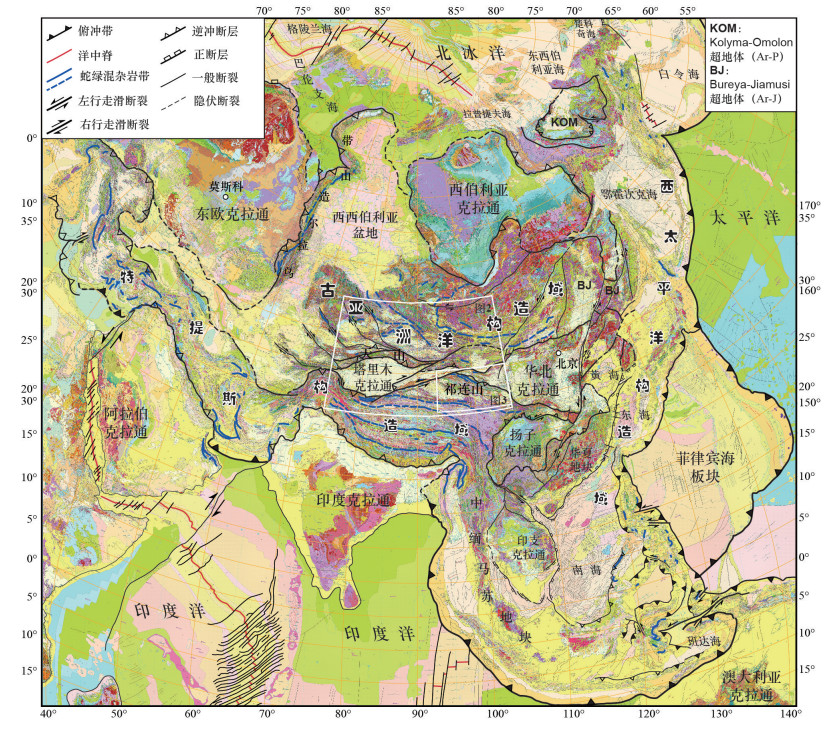
 下载:
下载:
